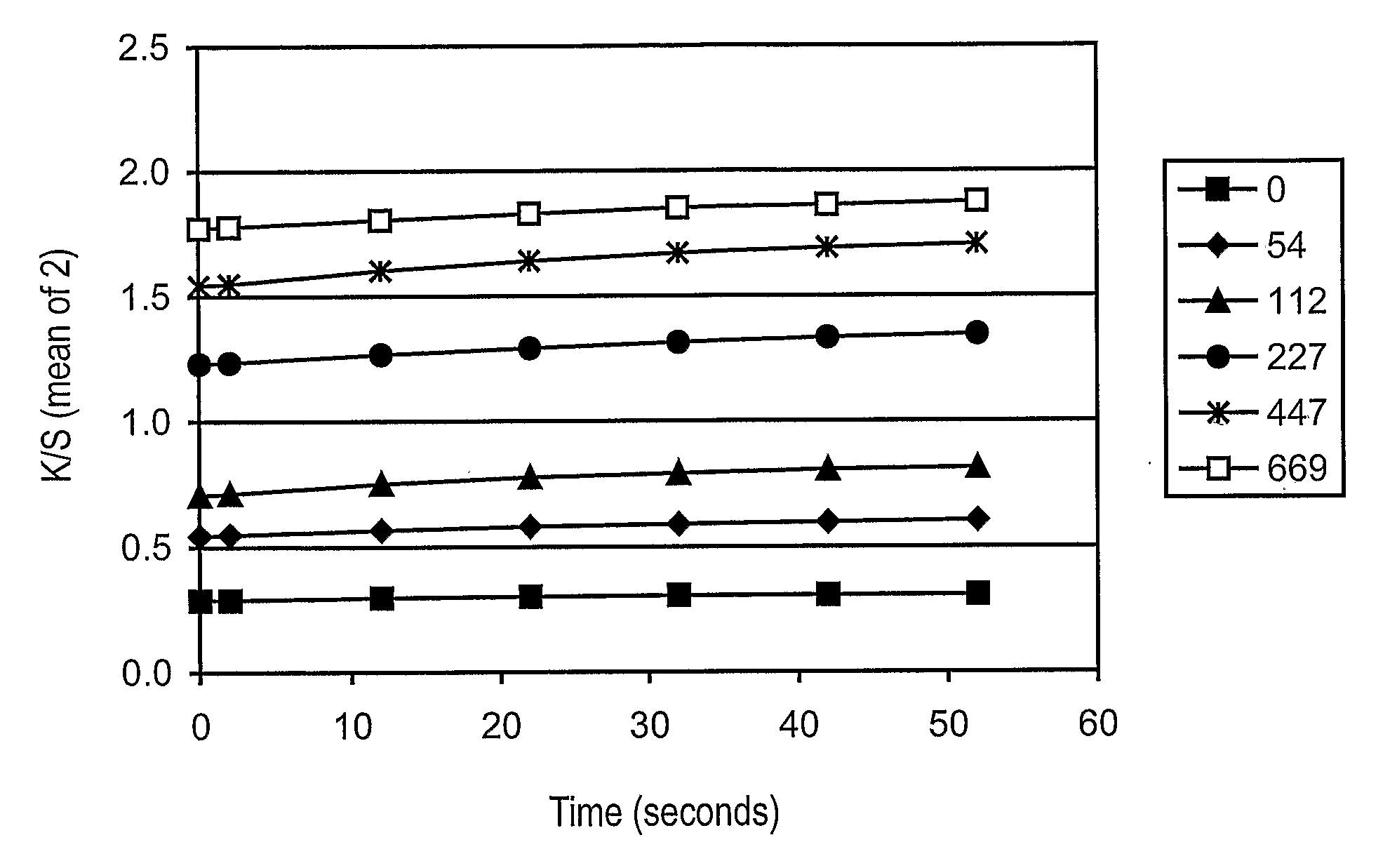Size Self-Limiting Compositions and Test Devices for Measuring Analytes in Biological Fluids
a technology of biological fluids and compositions, applied in the field of formulation, can solve the problems of retarded or incomplete movement of blood plasma carrying glucose to the reagents to develop color (or electrochemical response), and achieve the effect of rapid and stable respons
- Summary
- Abstract
- Description
- Claims
- Application Information
AI Technical Summary
Benefits of technology
Problems solved by technology
Method used
Image
Examples
example 1
[0050]A reagent layer was prepared by blending the components listed in Table A, applying them to a substrate, and completing the test strip as described above. The performance of the test strips was measured by adding a small sample of whole blood (about 600 nL) containing a known amount of glucose to the reagent layer, placing the strip in a small read area (e.g. 0.75 mm diameter) diffuse reflectance measuring instrument and reading the color developed over a period of about 60 seconds. The results are reported as K / S, the Kubelka-Munk function (1−R)2 / 2R where R is the measured reflectance. As will be seen in Fig a the measured color intensity remained constant over the period for each of the glucose concentrations tested. The response of the glucose meter was plotted versus the glucose content, as shown in FIG. 1b. It will be clear that the response time was rapid and that the results for 12 second and 52 seconds were very similar. Thus, one can conclude that the test strips of ...
example 2
[0051]Another reagent layer was prepared by blending the components listed in Table B, applying them to a substrate and completing the test strip as described above. A series of tests were carried out as in Example 1 with whole blood samples containing known amounts of glucose. The results of the tests are shown in FIGS. 2a-b. It will be seen that the color developed was substantially constant over a 60 second period of time, except that some additional color was developed at higher concentrations.
TABLE BComponentConcentrationPotassium phosphate, pH 7.5120 mmBentonite clay(1)0.78%Titanium dioxide(2)5.3% Ti02PSSA (70k)(3)1.8%Acrylic Latex(4)3.6%Zwittergent 3-12(5)0.2%WST-4 tetrazolium salt(6)40 mmNAD(7)10 mmDiaphorase(8)1900 μ / mLGlucose dehydrogenase(9)1100 μ / mL(1)Rheox, Bentone EW(2)Sigma-Aldrich, T-8141(3)Polysciences, Inc.(4)Dow, UCAR Latex 455(5)Calbiochem(6)Dojindo Laboratories(7)Sigma-Aldrich(9)Unitika, Diaphorase I(10)Amano Enzyme Inc., Amano 2
example 3
[0052]A reagent layer was prepared by blending the components listed in Table C, applying them to a substrate, and completing the test strip as described above. The reagent layer was tested as in Examples 1 and 2. The results are shown in FIG. 3a, b, c. FIGS. 3a and 3b report results similar to those of Examples 1 and 2. The additional color development at higher glucose concentrations noted in FIGS. 2a and b does not appear in this example.
[0053]Additional results are shown in FIG. 3c. Samples of whole blood having three distinct hematocrits (20%, 40%, 60%) were measured and the results plotted. It will be clear that the test strip of the invention is not affected significantly by the concentration of red blood cells in the blood.
TABLE CComponentsConcentrationHepes, half sodium salt(1)0.3 mBentonite clay(2)1.44%Titanium dioxide(3)8% Ti02Polyacrylic acid, sodium salt (60k)(4)3.85%PEG 8000(5)2.0%Rhodasurf-ON870(6)1.0%Gerepon T-77(7)0.6%Silwet L-7600(8)0.08%WST-4 tetrazolium salt(9)60...
PUM
| Property | Measurement | Unit |
|---|---|---|
| thickness | aaaaa | aaaaa |
| size | aaaaa | aaaaa |
| size | aaaaa | aaaaa |
Abstract
Description
Claims
Application Information
 Login to View More
Login to View More - R&D
- Intellectual Property
- Life Sciences
- Materials
- Tech Scout
- Unparalleled Data Quality
- Higher Quality Content
- 60% Fewer Hallucinations
Browse by: Latest US Patents, China's latest patents, Technical Efficacy Thesaurus, Application Domain, Technology Topic, Popular Technical Reports.
© 2025 PatSnap. All rights reserved.Legal|Privacy policy|Modern Slavery Act Transparency Statement|Sitemap|About US| Contact US: help@patsnap.com



